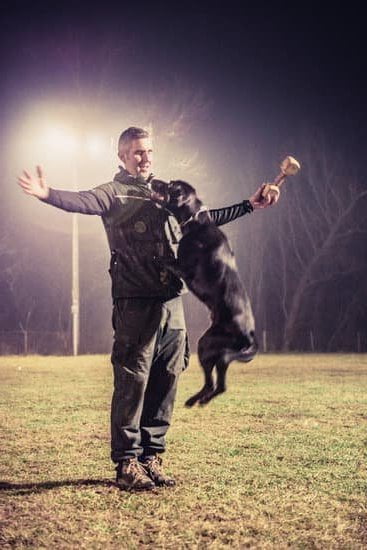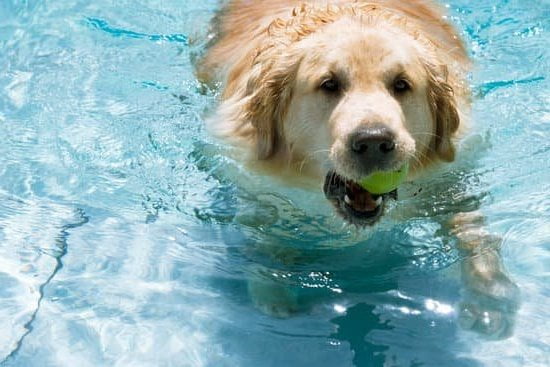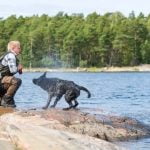Aggression in dogs can be a concerning and potentially dangerous issue. In order to effectively train a dog to be less aggressive, it is crucial to understand the root cause behind their behavior. Factors such as fear, past experiences, and territorial instincts can all contribute to a dog’s aggression. By delving into these underlying causes, we can approach the training process with empathy and tailor it to each individual dog’s needs.
Once we have gained an understanding of the root cause of aggression, the next step is assessing the severity and triggers of a dog’s aggressive behavior. This allows us to identify common signs of aggression and categorize their behavior accordingly. By pinpointing specific situations that provoke aggression, owners can better prepare for training sessions and implement appropriate techniques.
Developing a comprehensive training plan is essential when addressing a dog’s aggression. This plan should consider factors such as the dog’s temperament, age, and breed. Setting achievable goals, establishing consistent routines, and creating a positive training environment are all key components in this process. It is important to remember that patience and persistence are necessary for success, and seeking professional help may be beneficial in more complex cases.
By understanding the root cause of aggression, assessing its severity and triggers, developing a training plan, implementing positive reinforcement techniques, facilitating socialization and desensitization exercises, managing aggressive episodes effectively, maintaining consistency and follow-through in training sessions, and seeking professional help when necessary; we can work towards successfully training a dog to not be so aggressive.
Assessing Your Dog’s Aggression
When dealing with a dog that displays aggressive behavior, it is crucial to assess and understand the severity and triggers of their aggression. By accurately evaluating these aspects, owners can better strategize and implement appropriate training techniques to address the issue effectively. In this section, we will provide guidance on how to assess your dog’s aggression and categorize their behavior.
To begin assessing your dog’s aggression, it is essential to observe and identify common signs of aggressive behavior. These signs may include growling, baring teeth, lunging, snarling, or biting. Keeping a record of these behaviors can help create a clearer picture of when and why they occur.
Once you have identified the signs of aggression displayed by your dog, it is important to evaluate the triggers that elicit these behaviors. Triggers can vary from specific situations or stimuli such as strangers, other animals, resource guarding, or territorial instincts. Understanding what sets off your dog’s aggression will enable you to anticipate and prepare for those situations during training sessions.
| Signs of Aggressive Behavior | Examples |
|---|---|
| Fear Aggression | Lunging and barking at unfamiliar people or objects |
| Territorial Aggression | Guarding food or possessions aggressively |
| Resource Guarding Aggression | Biting or growling when someone approaches their food bowl or toys |
| Social Aggression | Reacting aggressively towards other animals or dogs during interactions |
By categorizing your dog’s aggression, you can prioritize areas of focus during training and seek professional guidance specific to the type of aggression displayed. Remember that accurately assessing your dog’s aggression is the first step towards finding a suitable treatment plan and achieving success in modifying their behavior.
Developing a Training Plan
When it comes to training a dog to not be so aggressive, it is crucial to develop a comprehensive training plan that takes into account the individual dog’s needs and behavior. By following a structured plan, owners can effectively address their dog’s aggression while ensuring a positive and consistent training experience. In this section, we will outline the essential steps to develop an effective training plan for reducing aggression in dogs.
Assessing the Dog’s Behavior
The first step in developing a training plan is to assess the dog’s aggression and behavior patterns. It is important for owners to observe and identify specific triggers or situations that provoke their dog’s aggressive response. By understanding what causes the aggression, owners can better prepare themselves for training sessions and implement appropriate techniques.
One helpful tool for assessing the dog’s behavior is a checklist of common signs of aggression. This checklist can include behaviors such as barking, growling, lunging, snapping, or biting. By documenting these behaviors and categorizing them based on severity, owners can have a clearer understanding of the extent of their dog’s aggression.
Setting Goals and Establishing Routines
After assessing the dog’s behavior, it is important to set achievable goals for the training process. Owners should identify specific behaviors they want to address and modify in their dog, such as reducing growling or preventing lunging towards strangers. These goals should be realistic and tailored to the individual dog’s needs and capabilities.
Once goals are identified, establishing consistent routines becomes essential. Dogs thrive on routine and structure; therefore, setting up regular training sessions at specific times each day can help create stability in their environment. Consistency is key when it comes to modifying any behavior, including aggression.
Creating a Positive Training Environment
Creating a positive training environment is crucial for successfully addressing a dog’s aggression. Positive reinforcement techniques, such as reward-based training and the use of verbal cues, can be highly effective in encouraging desirable behaviors.
During training sessions, it is important to remain patient and calm. Dogs are sensitive to their owner’s emotions and energy, so maintaining a positive and relaxed demeanor will help create a safe and comfortable environment for the dog. It is also important to avoid punishment or harsh methods, as this can escalate aggression rather than decrease it.
In addition to creating a positive environment during training sessions, it is equally important to establish a safe and enriching environment outside of training. Providing mental stimulation through interactive toys, engaging in daily exercise, and offering opportunities for socialization can help alleviate anxiety or stress that may contribute to aggression.
By following these steps in developing a training plan, owners can effectively address their dog’s aggression while promoting a positive and empathetic approach. It is essential to remember that each dog is unique, and what works for one may not work for another. If necessary, seeking professional help from a certified dog trainer or behaviorist can provide invaluable guidance throughout the training process.
Implementing Positive Reinforcement Techniques
Positive reinforcement is a powerful tool when it comes to training dogs to be less aggressive. By focusing on rewarding desired behaviors, we can effectively shape their behavior and encourage them to make better choices. In this section, we will explore various positive reinforcement techniques that owners can implement in their training sessions.
One of the most popular methods of positive reinforcement is reward-based training. This technique involves providing treats, praise, or toys as rewards for good behavior. When the dog displays calm and non-aggressive behavior, owners should immediately provide a reward to reinforce that behavior. Over time, the dog will associate these rewards with positive actions and be more likely to repeat them.
Another effective technique is clicker training. A clicker is a small handheld device that makes a distinct clicking sound when pressed. The click serves as a marker to indicate the exact moment the dog performs a desired behavior. By pairing the click with a treat or reward immediately after, the dog learns to associate the click with positive reinforcement. Clicker training allows for precise communication and helps dogs understand which behaviors are being rewarded.
Verbal cues can also play an important role in positive reinforcement training. Owners can use specific words or phrases such as “good boy” or “yes” to signal that the dog has done something right. Consistent use of these verbal cues will help reinforce positive behaviors and establish clear communication between owner and dog.
It’s important to note that positive reinforcement techniques should be used consistently and in conjunction with other aspects of an effective training plan. While it may take time and patience, reinforcing desirable behaviors will gradually reduce aggression and replace it with more appropriate responses.
Socialization and Desensitization
Socialization and desensitization are vital aspects of training a dog to be less aggressive. By exposing dogs to various social situations in a controlled and positive manner, owners can help them develop better behavior and reduce potential triggers.
One effective method of socialization is gradually introducing the dog to new environments, people, and other animals. This can be done by starting with low-stress environments and gradually increasing the level of exposure. For example, taking the dog on short walks in quiet areas and slowly progressing to busier parks or dog-friendly events. It is important to closely monitor the dog’s reactions during these experiences and provide positive reinforcement for calm behavior.
Desensitization exercises are also crucial in helping dogs overcome specific fears or anxieties that may contribute to their aggression. The goal is to expose the dog to the trigger in a controlled way, gradually increasing their tolerance over time.
For example, if a dog is fearful or aggressive towards strangers, the owner can start by having a familiar person approach from a distance while providing treats or rewards for calm behavior. As the dog becomes more comfortable, they can gradually decrease the distance between themselves and unfamiliar individuals.
In addition to socialization and desensitization exercises, it is essential for owners to create a safe environment for their dog during training sessions. This includes removing any potential triggers or distractions that may lead to aggression. It is also important for owners to remain calm and patient during training sessions as dogs can pick up on their owner’s emotions. Reinforcing positive behaviors consistently and rewarding progress is key in encouraging desired behavior changes.
By implementing socialization and desensitization techniques into their training plan, owners can effectively decrease their dog’s aggression towards humans, animals, or strangers. However, it is important for owners to remember that every dog is unique and may require different strategies or additional professional help depending on the severity of their aggression.
Managing Aggressive Episodes
In this section, we will provide readers with practical tips on how to handle and de-escalate potential conflicts safely. Aggressive episodes can be challenging and potentially dangerous, so it’s important for dog owners to know how to manage them effectively while working towards modifying their dog’s behavior.
- Maintaining a Calm Demeanor: One of the most crucial aspects of managing aggressive episodes is maintaining a calm demeanor yourself. Dogs are highly intuitive, and if they sense that their owner is anxious or agitated, it can escalate their aggression further. Taking deep breaths, speaking in a soothing voice, and avoiding sudden movements can help create a more peaceful environment during these situations.
- Using Leashes or Muzzles: In some cases, using a leash or muzzle may be necessary to ensure everyone’s safety during aggressive episodes. These tools provide better control over the dog’s movements and limit their ability to harm others or themselves. It’s important to introduce leashes and muzzles gradually and positively associate them with rewards to minimize any discomfort or anxiety the dog may experience.
- Seeking Professional Guidance: For cases of severe aggression or if previous attempts at managing aggressive episodes have been unsuccessful, seeking professional guidance is recommended. Certified dog trainers or behaviorists have expertise in dealing with aggression issues and can tailor a training plan specific to your dog’s needs. They can provide valuable insights and techniques that can effectively address the underlying causes of aggression.
It’s important for dog owners to remember that managing aggressive episodes is just one part of the training process. Consistency and follow-through with the overall training plan are essential for long-term behavior modification success. By staying committed to the training plan, reinforcing positive behaviors consistently, and avoiding mixed signals that may confuse the dog, owners can create an environment conducive to positive change.
| Tips for Managing Aggressive Episodes |
|---|
| Maintain a calm demeanor |
| Use leashes or muzzles |
| Seek professional guidance if needed |
Consistency and Follow-through
Maintaining a Consistent Routine
Consistency is crucial when training a dog to be less aggressive. Dogs thrive on routine and predictability, so it’s important to establish and maintain a consistent training schedule. This means setting aside regular time each day for training sessions and sticking to that schedule as much as possible.
Consistency also extends to other aspects of the dog’s daily routine, such as feeding times, exercise routines, and sleeping arrangements. By providing clear expectations and structure, owners can help their dog feel more secure and reduce the likelihood of aggression.
Reinforcing Positive Behaviors Consistently
Consistency in reinforcing positive behaviors is essential for effective training. When your dog exhibits desired behaviors, such as calmness or gentle play, it’s important to provide immediate positive reinforcement. This can include verbal praise, treats, or playtime with a favorite toy.
Consistency in rewarding positive behavior helps the dog associate those behaviors with positive outcomes and encourages them to repeat them in the future. Conversely, it’s equally important to consistently ignore or redirect undesirable behaviors without rewarding them inadvertently. This helps prevent any confusion for the dog and reinforces the focus on positive behaviors.
Avoiding Mixed Signals
Mixed signals can confuse dogs and undermine their training progress. It’s important for owners to be clear and consistent in their communication with their pets.
For example, if jumping up is an undesired behavior that triggers aggression in the dog, everyone in the household should respond to jumps consistently by not giving attention or rewards until the dog calms down. If one family member allows jumping while another discourages it, this can create confusion for the dog and hinder progress in reducing aggression.
It’s also important to use consistent cues or commands when teaching new behaviors or giving instructions during training sessions. Using a variety of words or gestures for the same command can make it difficult for the dog to understand what is expected of them. Consistency in the way commands are given helps the dog associate specific actions with specific cues, making it easier for them to learn and respond appropriately.
Tracking Progress Regularly
To ensure ongoing success and identify areas that may need further attention, it’s important for owners to track their dog’s progress regularly. This can be done through behavioral logs or journals where they record the dog’s reactions to various situations, any triggers for aggression, and their overall behavior improvements over time.
Tracking progress allows owners to better understand their dog’s patterns and make necessary adjustments to training techniques or seek professional guidance if needed. Additionally, celebrating small victories and milestones along the way helps maintain motivation and positivity throughout the training process.
Seeking Professional Help
Seeking professional help is an essential step in addressing aggression in dogs. While the previous sections of this article have provided valuable information and strategies for training a dog to be less aggressive, there may be cases where more specialized assistance is required. Professional intervention is especially crucial for complex cases of aggression or when the safety of humans or other animals is at risk.
When considering the need for professional help, it is essential to seek out certified dog trainers or behaviorists who specialize in aggression cases. These professionals have the knowledge and experience necessary to assess your dog’s behavior accurately and design a tailored behavior modification plan. They can provide invaluable guidance, support, and expertise throughout the training process.
Working collaboratively with a professional trainer or behaviorist will ensure that you receive accurate assessments and effective training techniques specific to your dog’s needs. They can help you identify triggers, develop behavior modification strategies, and provide ongoing guidance as you work towards reducing your dog’s aggression.
Remember that seeking professional help does not mean you have failed as a dog owner. In fact, it shows your commitment to your dog’s well-being and safety. With their expertise and guidance combined with your dedication and consistency, you can create a positive training environment that promotes healthier behaviors in your beloved pet.
Frequently Asked Questions
Can a dog be trained to not be aggressive?
Yes, a dog can be trained to not be aggressive. Aggression in dogs can stem from various factors such as fear, resource guarding, territorial behavior, or poor socialization. The key to addressing aggression is understanding the underlying cause and working with a professional dog trainer or behaviorist.
It’s essential to use positive reinforcement techniques that reward calm and non-aggressive behavior while redirecting or managing triggers that may elicit aggression. Consistency, patience, and ongoing training are crucial in modifying a dog’s aggressive tendencies.
How do I stop my dog from being aggressive?
Stopping a dog from being aggressive requires a multifaceted approach. Firstly, it is important to identify the triggers that elicit aggression and avoid exposing the dog to those situations whenever possible. Consultation with a professional dog trainer or behaviorist is highly recommended to evaluate your specific situation and provide appropriate guidance.
Implementing consistent training using positive reinforcement techniques will help reframe the dog’s response to triggers. It’s crucial for owners to establish themselves as authoritative yet compassionate leaders without resorting to punishment-based methods which might escalate aggression further.
How do you muzzle train an aggressive dog?
Muzzle training an aggressive dog involves desensitizing them to wearing a muzzle gradually. The process starts by introducing the muzzle as an object of positive association rather than something threatening. Begin by showing the muzzle and rewarding the dog for calmly investigating or approaching it voluntarily using treats or praise.
Slowly progress to touching their snout with the muzzle while rewarding their acceptance until they become comfortable with this step. Gradually work up to buckling and fastening the muzzle while associating it with positive experiences like going for walks or receiving treats during wear time. Professional guidance is helpful during this process since every dog may have different levels of comfort or resistance, requiring personalized approaches for successful muzzle training.

Welcome to the blog! I am a professional dog trainer and have been working with dogs for many years. In this blog, I will be discussing various topics related to dog training, including tips, tricks, and advice. I hope you find this information helpful and informative. Thanks for reading!





